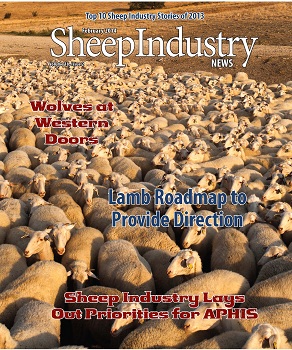
- February 2014
- President’s Notes
- Market Report
- American Lamb Industry Announces Final Roadmap
- Looking Back: Top 10 Sheep Stories of 2013
- Sheep to Shawl
- Sheep Growing Senator Weighs in on Idaho Wolf Debate
- Are Your Ewes Pregnant?
- Economist Sees Bumpy Years for U.S. Ag
- New Farm Bill May Bring Insurance Issues
- New Wool Yarn Mill Filling Niche
- College Wool Judging Teams Pick Up Skills Together at Belle Fourche Clinic
- ASI Offers Sheep Priorities to APHIS
- Utah Farm Bureau: States Can Manage Wolves
- Farmland Prices Rise, But How Long is Ride?
- Sheep Heritage Contributors
- Obituaries
Looking back: Top 10 Sheep Stories of 2013
Sheep and wool producers often don’t like to look – or even glance – in the proverbial rear-view mirror. But as the saying goes, “you can’t understand where you’re going unless you can recognize where you’d been.” With that in mind – and with credit to the staff and membership of the American Sheep Industry Association – here are the “Top 10 Sheep Stories of 2013.”
1. LAMB PRICES RECOVER – Feeders finally returned to profitability in September. Also, prices paid for feeder lambs rose above cost of production for the first time following the volatile markets of 2011 – 2013.
2. ASI ROLLS OUT NEW MARKET APP – ASI launched its first mobile application providing lamb and wool market information to anyone with a smartphone or tablet allowing producers to tap into auctions and prices. The app is titled ASI Market News. Download it today.
3. A $5 MILLION LAMB BUY – In July, the U.S. Department of Agriculture’s (USDA) Agriculture Marketing Service announced a $5 million purchase of lamb products for federal food nutrition assistance programs. ASI requested the lamb meat purchase to prompt stronger prices for lambs at the farm and ranch gate. In the first half of the year, live lamb prices were below the cost of production and producers were facing the 12 Sheep Industry News l sheepindustrynews.org The overall markets for sheep, lambs and wool saw some improvement during 2013, as feed prices trended lower and animal health issues improved across the country. Looking back: Top 10 Sheep Stories of 2013 February 2014 13 highest feed costs in years.
4. INDUSTRY ROADMAP FINAL REPORT – The Roadmap Advisory Committee published the final version of the American Lamb Industry Roadmap Report. This collaborative effort provides a strategy for the industry that will strengthen its short- and long-term competitive advantage and return the industry to consistent profitability. The four high-level goals as identified in the roadmap are product characteristics, demand creation, productivity improvement and industry collaboration.
5. LAMB CHECKOFF RATE INCREASED – The new lamb checkoff rate went into effect on June 13 increasing the assessment from $.005 to $.007 per pound for live sheep and lambs sold by producers, feeders and seedstock producers. For sheep and lamb purchased for slaughter by first handlers, the rate increased from 30 cents to 42 cents per head. The assessment rate change, which was supported by ASI, will generate about $700,000 additional funds for ALB programs.
6. GISPA REPORT RELEASED – The investigation by the Packers and Stockyards Program’s found that many market factors interacted to cause the sharp increase and subsequent decrease in lamb prices that occurred during 2010, 2011 and 2012. According to the report, the rising cost of imported lamb was likely the most important factor.
7. INSTRUMENT GRADING MOVES FORWARD – The last of the cut-out data was captured in November and will be summarized, validated and standardized by USDA for future use in assigning USDA Quality and Yield Grades. The use of instrument grading provides for the opportunity to reduce variability in the subjective application of yield grades to lamb carcasses, improving the predictability of the saleable cuts and the ability to establish value-based returns on quality lambs. ASI initially launched the project that was then co-funded by ALB and the National Sheep Industry Improvement Center to finalize the grading standards and to evaluate the benefits and effectiveness of the system.
8. THE NLPA’S LENDING PROGRAM INCLUDES FUNDING FOR FLOCK EXPANSION – Up to $2 million of the National Livestock Producers Association’s Sheep (NLPA) and Goat Fund was identified to be used specifically for the purchase of breeding animals (ewes and rams). This new loan program is the result of a joint effort between NLPA and ASI in the spirit of ASI’s Let’s Grow initiative.
9. REVISED SCRAPIED FLOCK CERTIFICATION – The revised Scrapie Flock Certification Program (SFCP) went into effect on June 3 allowing sheep and goat producers to increase the marketability of their animals by demonstrating a negligible scrapie risk in their flock. The revised SFCP enhances the scrapie surveillance strategy and helps in the final push to eradicate this disease from the United States. Also, In December, the Animal and Plant Health Inspection Service (APHIS) moved its national scrapie database to a new platform. As a result, the web address for the Scrapie Flock Certification Program changed to https://vsapps.aphis.usda. gov/scrreports/sfcpHome.
10. COOL TAKES EFFECT – The new Country of Origin Labeling (COOL) rule took effect on Nov. 23. Labels now refer to born, raised and harvested according to applicable country. U.S. legislators in Washington are in the process of drafting a new Farm Bill, and Canada — along with U.S. meat and livestock groups that also oppose the labelling rules — hope to dial up the pressure. ASI supports the mandatory labeling of American lamb.
So that’s it for 2013.
What about 2014? Sheep Industry News intends to keep you informed of developments throughout the year.

